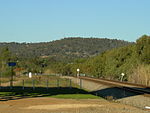Bushmead, Western Australia
Perth, Western Australia geography stubsSuburbs and localities in the City of SwanSuburbs of Perth, Western AustraliaUse Australian English from August 2019
Bushmead (postcode: 6055) is a suburb of Perth in the City of Swan located 16 kilometres (9.9 mi) from Perth's central business district.
Excerpt from the Wikipedia article Bushmead, Western Australia (License: CC BY-SA 3.0, Authors).Bushmead, Western Australia
Northgate Promenade, City Of Swan
Geographical coordinates (GPS) Address Nearby Places Show on map
Geographical coordinates (GPS)
| Latitude | Longitude |
|---|---|
| N -31.925 ° | E 116.025 ° |
Address
Northgate Promenade
Northgate Promenade
6057 City Of Swan (Bushmead)
Western Australia, Australia
Open on Google Maps







